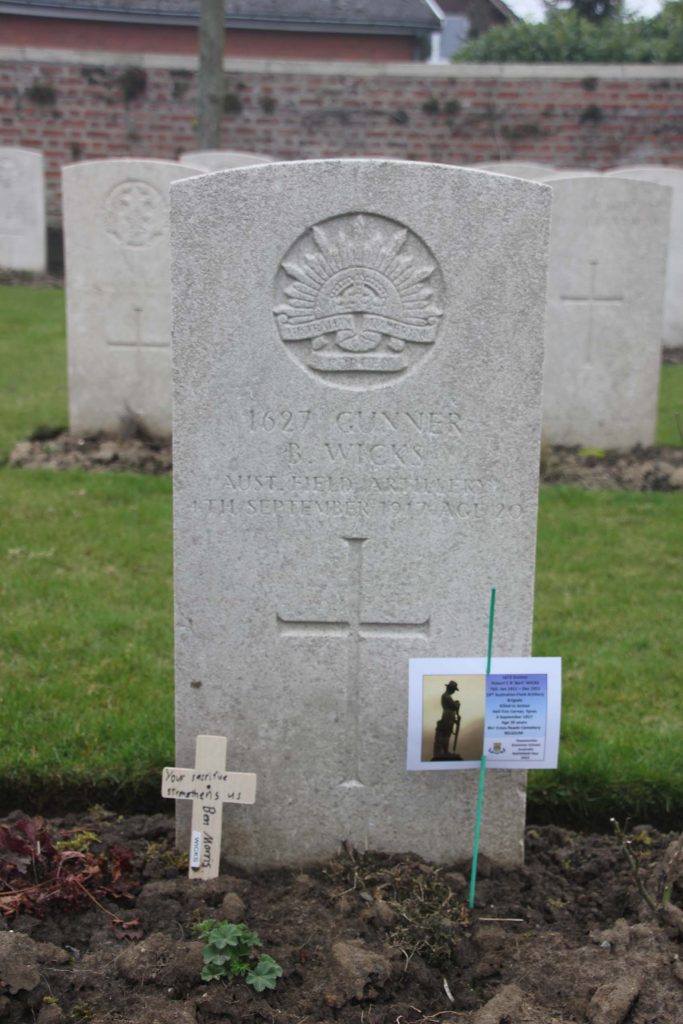This soldier was known always as Bert Wicks. No other name was used by him or his family in the documents, nor was any other given name used by the army. Bert was a young bank teller working in Brisbane and boarding privately in West End when he enlisted on 29 July 1915. He was the son of school-teaching parents George Henry and Elizabeth Wicks, of the State School at Blackall in western Queensland; he had turned 18 years of age in the month before he volunteered. Bert was born at Oakey and attended the Toowoomba Grammar School where he graduated in 1914. When he signed up Bert needed the permission of his parents to serve overseas; their permission was wired to the army in Brisbane from Blackall. With youth and a healthy physique George made a good soldier. He was 5’9” tall and weighed 132 pounds. He had a fair complexion, blue eyes and brown hair; he was a member of the COE and could handle a horse well enough to be posted to the 5th Light Horse Regiment at Enoggera. He named his mother as NOK.
Five months after beginning his training Bert was posted overseas, leaving Brisbane aboard A23 Suffolk on 30 November 1915. When he enlisted Bert needed the permission of his parents to serve; he could not vote; he could not buy a beer in a hotel. When he left, Bert was a married man, an expectant father and was ready to die for his country. Not long before embarkation he married Ellen Isabella who lived at Beerburrum while her young husband was in Europe.
Bert spent the first half of 1916 in Egypt. He had arrived after the withdrawal from Gallipoli and the 5th LHR was soon at full strength bolstered by reinforcements already in Egypt. Bert was transferred to the artillery in March and posted to the 53rd Battery of 14th Field Artillery. He continued training until 20 June when the battery boarded ship for France. Bert’s career in France followed familiar lines. He was lightly wounded in the last phases of the Somme campaign. A slight head wound saw him evacuated to Rouen for treatment. His anxious mother cabled the army wondering where he was and needing to know if he was suffering. He was able to rejoin his unit on 12 December.
In 1917 Bert fought continuously with his battery, remaining safe and well, until, in the autumn, the AIF was drawn into the horrendous Battle of Passchendaele. In continuous fighting between July and October almost 40 000 Australians became casualties. On 4 September Bert was sheltering in a dugout with four or five other men. A German shell landed directly on their “possie”; a mate wrote later, Gnr Wicks was killed on the morning of the 4th at about 11 o’clock. He was in a “Pill box” dug out with other men near Hell Fire Corner in the Ypres area when an enemy high explosive shell hit the dugout, the roof collapsing with the force of the explosion burying the occupants in the dug-out. Death in the case of Gnr Wicks must have been instantaneous, as there were severe wounds . . . . He was buried close to the dugout, the burial service being read by one of the sergeants of the battery. A cross was erected over the grave. No-one in the dugout survived.
In Australia Bert’s parents came to terms with the fact they were no longer his official NOK. Elizabeth Wicks wrote to the authorities several times regarding mementoes issued by government that she might treasure. In November 1920 she inquired of the Defence Minister, I wish to apply for a brochure, entitled “Where the Australians Rest” published under your direction, to be forwarded to the next-of-kin. I am not the next-of-kin (my boy being married) but he was my only son, and was killed at Ypres. From the school house at Redland Bay in September 1922 she asked about the Memorial Plaque sent to NOK: Bert was my only son & I am wondering if I could also get a plaque, is there something a mother can get; before leaving home he was a little pal of mine, but was working in a bank away from home. . . . His death was a terrible blow to us and still is.
Bert, aged 20, was buried at Birr Cross Roads Cemetery (grave II.B.11), son of Elizabeth and George, husband of Ellen and father of Mathew, whom he never saw.
Toowoomba Grammar School Archive Records state that he started school on 31st January 1911 and left on 16th December 1911. The School Magazine dated November 1917 stated. ‘WICKS, R. C. B. (Bert.)-Only son of Mr. and Mrs. G. H. Wicks, State School, Blackall. At School 1911-Killed in action in France, September 4th, 1917. Age 20.’
External Links
Australian Red Cross Society Wounded and Missing
AWM4 AIF unit war diaries 13/41/15 14TH AFA BDE
Australian War Memorial Honour Roll
Australian National Archives Military Records
https://vwma.org.au/explore/units/232
https://trove.nla.gov.au/newspaper/article/20193698

12th Field Artillery – AWM E00430

14th Battery of Australian Field Artillery

Hell Fire Corner on the Menin Road – AWM E01889

Hell Fire Corner Map

Bert Wicks is on the Blackhall, Queensland Memorial as R Wicks

Headstone for Bert Wicks taken by Ann Hallam




